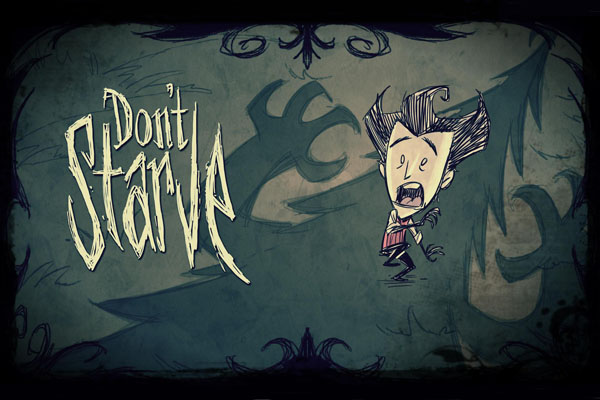Quench your gaming appetite with Don’t Starve

April 2, 2014
What do giant spiders, killer bees, and wolves have in common? They are all the least of your concerns in Don’t Starve.
Don’t Starve is an action-adventure, survival game from indie developer Klei Entertainment. Originally released on the PC in early 2013, a port of the game came out on the Playstation 4 earlier this year.
At the start of the game, you control Wilson, a scientist struggling to accomplish anything with his experiments. When a voice on his radio starts talking directly to him, he builds a large, ominous looking machine on the behest of the voice. Upon activation of the machine, Wilson is teleported to a strange world, where he discovers that he was tricked by the voice, who reveals himself as a demon named Maxwell. The “Gentleman Scientist” is then left stranded and must survive with only his intellect and any resources he can scavenge from the environment.
As you can probably guess by the name, the main goal of Don’t Starve is to avoid (starving to) death. At first, this may sound like a simple enough task, but you’ll find out fast that the game does not kid around. When you die, that’s it; game over. Without a tutorial or hints of any kind, you are left to your own devices to figure out how to survive.
Throughout the game, the state of your character is dictated by three different gauges. The first one is the hunger gauge. This tells you how full your character’s stomach is and can be used to figure out how much food you need to have on you and when you should eat it. The second gauge measures your health. This shows how physically damaged you are and is depleted by enemy attacks. The third gauge measures you sanity. A number of factors affect your sanity including the monsters you run into, the food you eat, or even the items you keep in your inventory.
For the most part, you will end up splitting your time between three different things: scavenging, crafting, and exploring. In order to last through the first day, you are going to have to gather supplies from the environment. For the bare minimum, you will need a source of food and a fire to keep monsters from attacking you. If you want more out of the game than just basic survival, you can craft items with the resources you gather. Items range from simple campfires to earmuffs made out of live rodents. Each item requires different things to produce them, so keeping track of your limited inventory space is necessary. In order to find some of the parts to craft the various items, you will have to explore the map. This can be sort of difficult to deal with at first, as the layout of the world is randomly generated with each new save file. Even if you don’t focus your time on crafting, it’s a good idea to explore so that you know what to expect in the future.
While the game plays fine when you use a controller, it is very easy to tell that it was originally designed for PC. The inventory and crafting menus are each a row of boxes that go across the bottom and left side of the screen respectively. This is a staple of PC games, allowing a simple way to sort through things with the standard keyboard and mouse setup. It isn’t too apparent until around ten or so minutes into the game when you have to start managing the decreasing space in your inventory. Even then though, it’s only a small annoyance that can be handled rather easily.
One of the best and also one of the worst things about Don’t Starve is how addicting it can get. If you can manage to stay alive for a decent stretch of time, you will eventually want to stop playing. Just like any other person, you have different things you could spend your time on, but the game compels you to stay. You don’t want to sit and wait for your character to perish, as this would make you feel like you wasted your time and you’re simply giving up. Also, you could save the data and come back to it later, but then you might forget the masterfully crafted survival plan you laid out for yourself. The only option then is to keep playing until your character meets the demise that he deserves, whether it takes five minutes or five hours.
Another thing that Don’t Starve is good for is having the most standard, lackluster combat that an action-adventure game can have. In Don’t Starve’s case, this is a good thing. By having such mediocrity, it makes fighting a less than admissible choice. The game forces you to think your way through a potentially deadly situation instead of running in, guns blazing.
If you can appreciate a challenge, you’ll love Don’t Starve. It takes such a basic concept as avoiding death and crafts it into a frustratingly addictive experience. While some technical aspects don’t translate over to the PS4 version as smoothly as they could have, this unique game deserves a second look if you passed on it the first time around.


